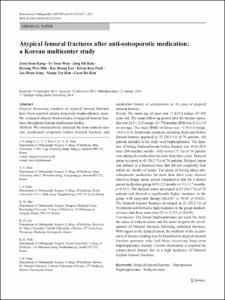KUMEL Repository
1. Journal Papers (연구논문)
1. School of Medicine (의과대학)
Dept. of Orthopedic Surgery (정형외과학)
Atypical femoral fractures after anti-osteoporotic medication: a Korean multicenter study
- Keimyung Author(s)
- Min, Byung Woo
- Department
- Dept. of Orthopedic Surgery (정형외과학)
- Journal Title
- International Orthopaedics
- Issued Date
- 2014
- Volume
- 38
- Issue
- 6
- Abstract
- Purpose
Increasing numbers of atypical femoral fractures have been reported among long-term bisphosphonate users. We evaluated clinical characteristics of atypical femoral fractures throughout Korean multicenter studies.
Methods
We retrospectively analysed the bone mineral density, prodromal symptoms before femoral fracture, and medication history of osteoporosis in 76 cases of atypical femoral fracture.
Results
The mean age of cases was 71.4 ± 8.8 (range, 43–89) years old. The mean follow-up period after the fracture operation was 24.5 ± 12.9 (range, 12–79) months. BMI was 23.2 ± 3.0 on average. The mean BMD of femur was −1.9 ± 1.4 (range, −4.8 to 1.3). Prodromal symptoms including thigh pain before femoral fracture appeared in 22 (28.9 %) of 76 patients. All patients included in the study used bisphosphonate. The duration of taking bisphosphonate before fracture was 36.8 ± 50.8 (one–204 months) months. Fifty-seven (75 %) of 76 patients were taking the medication for more than three years. Delayed union occurred in 43 (56.5 %) of 76 patients. Delayed union was defined as a fractured bone that did not completely heal within six months of injury. The group of having taken anti-osteoporotic medication for more than three years showed relatively longer union period compared to that for a shorter period medication group (4.8 ± 2.5 months vs 9.3 ± 3.7 months, p = 0.017). The delayed union developed in 43 (56.5 %) of 76 patients and showed a significantly higher incidence in the group with long-term therapy (five/43 vs 38/43, p = 0.021). The bilateral femoral fractures developed in 23 (30.2 %) of 76 patients and showed a high incidence in the group medicated more than three years (two/23 vs 21/23, p = 0.039).
Conclusions
The longer bisphosphonates are used, the more the cases of delayed union and the more frequent the development of bilateral fractures following unilateral fractures. With regard to the delayed union, the methods of the acceleration of fracture healing may be beneficial in atypical femoral fracture patients who had been receiving long-term bisphosphonates therapy. Careful observation is required for contra-lateral femurs due to a high incidence of bilateral atypical femoral fractures.
Keywords
Atypical femoral fracture – Osteoporosis – Bisphosphonates – Delayed union
- Keimyung Author(s)(Kor)
- 민병우
- Publisher
- School of Medicine
- Citation
- Joon Soon Kang et al. (2014). Atypical femoral fractures after anti-osteoporotic medication:
a Korean multicenter study. International Orthopaedics, 38(6), 1247–1253. doi: 10.1007/s00264-013-2259-9
- Type
- Article
- ISSN
- 0341-2695
- Appears in Collections:
- 1. School of Medicine (의과대학) > Dept. of Orthopedic Surgery (정형외과학)
- 파일 목록
-
-
Download
 oak-aaa-02281.pdf
기타 데이터 / 507.05 kB / Adobe PDF
oak-aaa-02281.pdf
기타 데이터 / 507.05 kB / Adobe PDF
-
Items in Repository are protected by copyright, with all rights reserved, unless otherwise indicated.